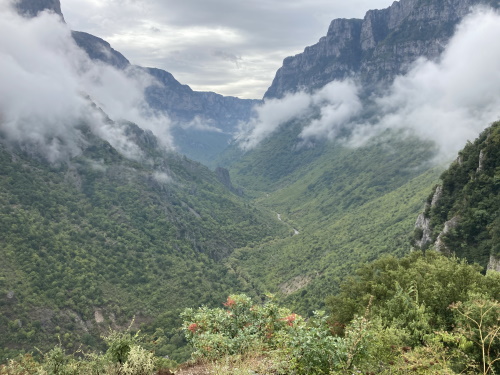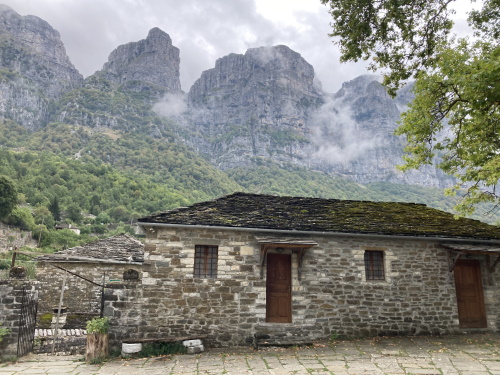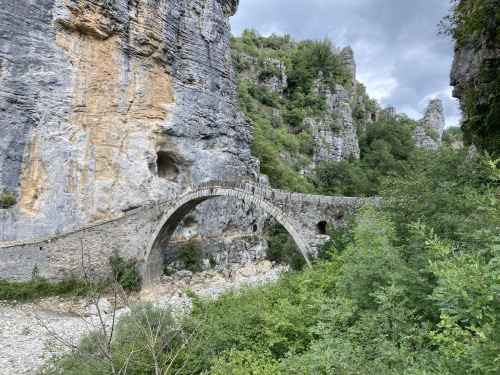Blog TWHS Visits
Zagori & Pindos
Zagori and the Pindos mountains will be Greece’s nomination for 2023. It will be a shoo-in, I can already see ICOMOS drooling over features such as “traditional villages with vernacular architecture” and “bridges sponsored by wealthy merchants”. It’s a wonderful site to visit as well: this is a region in Northern Greece that for long has been a well-kept secret within the hiking community. It will be a mixed proposal, combining the cultural features of Zagori with the Pindos Mountains. Northern Pindos National Park is a UNESCO Global Geopark already, so it’s well-protected and has an abundance of information panels both on the area’s geology, plants, and fauna as well as on its villages.
I stayed in the area for 2 nights, exploring it by rental car from a guesthouse in a traditional home in Asprangeloi. On the first day, I focused on the northwest of the region, and on the second day on the southeast. Although the distances are short, the driving takes a lot of time because of the winding, minor roads. The roads were never too narrow though and there is little traffic, so it was fun to drive.
I started my visit by going to the village of Vikos in the early morning. It has a good viewpoint of the Vikos Gorge. The town itself, like many others I would encounter, felt deserted. One shouldn’t be too early in the morning for a good look at the gorge, as it is covered in clouds often. It had rained heavily overnight as well, a common feature in the Pindos mountains.
I then drove much further north, to the twin villages of Mikro and Megalo Papingo. These are very picturesque because of their stone houses. I left my car at the large parking lot just at the town entrance of Megalo Papingo, and then hiked the final 3km to Mikro Papingo. I followed the main road for a while (there is hardly any traffic anyway) until I saw a sign for a shortcut trail across the valley towards Mikro Papingo. This path took me across my first stone bridge, one of the characteristic features of this region.
I had lunch in the somewhat larger town of Vitsa (many of the smaller ones have no amenities at all) and drove through the popular town of Monodéndri. I couldn’t find parking there, so I drove on towards two of the major stone bridges. The Noutsou bridge has a spectacular setting between two huge cliff faces. The Bridge of Plakidas has 3 arches (you’ll only see all 3 when you walk there). It was getting later in the afternoon already and dark clouds had gathered, but I pushed on to the village of Vradeto, where ancient stone stairs apparently can be seen. However, it poured when I arrived so I just turned around my car.
The next day I moved to the other end of this region. Even taking the main road around it took me 1.5 hours to arrive in the village of Trísteno. This is a less densely populated area than the northwest, but the forested scenery of the Pindos Mountains is pretty. In Trísteno I stumbled upon the early morning coffee session of the elderly population and its priest at the village square. The squares here in Zagori are really one of the outstanding features. They are hard to describe – they are oversized and there always seems to be a large old tree and a low church. It may sound like a colonial town in Mexico, but it’s a totally different setting. A better comparator for this region would be Svaneti.
The furthest north I got was to the Bridge of Vovousa, which spans a river in the town center. There are many more villages and stone bridges to be found than I have mentioned above, as well as longer hikes to do and some monasteries to visit. It would take days to see it all. Tourism in the area still is pleasantly low-key, as is the Epirus region overall.
Els - 11 September 2022
Comments
Esteban Cervantes Jiménez 12 September 2022
Love this kind of cultural landscapes: mountainous areas with great nature and landscapes, as well as great culture, vernacular architecture and small towns, that can be very welkkl experienced by hiking. Hope to see it next year become Greece's 19th site and the 1st one for the Epirus region. And hope to get there one day.


